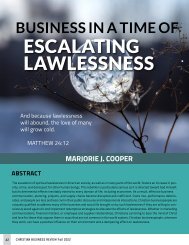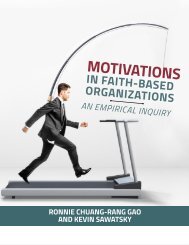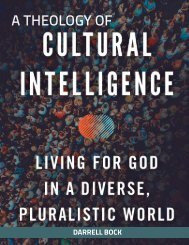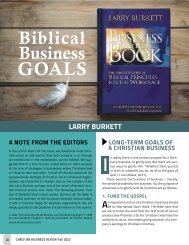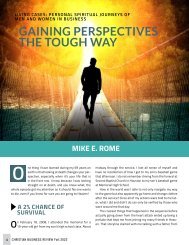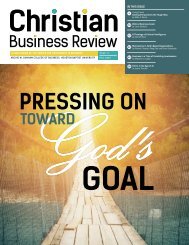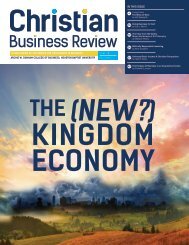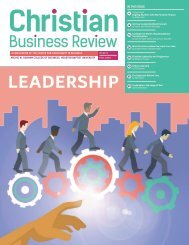Christian Business Review 2018: Kingdom Business in the Brave New World (Issue 7)
You also want an ePaper? Increase the reach of your titles
YUMPU automatically turns print PDFs into web optimized ePapers that Google loves.
communication technologies<br />
CBR PEER REVIEWED ARTICLES<br />
particularities of <strong>the</strong> relationship. For example, shar<strong>in</strong>g<br />
<strong>in</strong>timate details about oneself with a spouse or very close<br />
friend who holds that <strong>in</strong>formation <strong>in</strong> confidence is healthy.<br />
Shar<strong>in</strong>g <strong>the</strong> same <strong>in</strong>formation with a neighborhood acqua<strong>in</strong>tance,<br />
who <strong>the</strong>n shares it with o<strong>the</strong>rs, might be quite<br />
unhealthy. In <strong>the</strong> latter case, <strong>the</strong> depth of <strong>the</strong> relationship<br />
is not commensurate with <strong>the</strong> <strong>in</strong>formation shared; <strong>the</strong>re<br />
may be <strong>in</strong>appropriate vulnerability not supported by <strong>the</strong><br />
reality of <strong>the</strong> relationship. In o<strong>the</strong>r words, <strong>the</strong>re may be unfounded<br />
assumptions about trust with <strong>the</strong> acqua<strong>in</strong>tance.<br />
Intimate relationships could be unhealthy <strong>in</strong> an opposite<br />
way. Be<strong>in</strong>g unwill<strong>in</strong>g to share personal vulnerability with<br />
anyone – <strong>in</strong>clud<strong>in</strong>g close friends or family members – is a<br />
marker of low trust levels and an unhealthy relationship.<br />
Of course, appropriate levels of trust are predicated on<br />
<strong>the</strong> trustworth<strong>in</strong>ess of <strong>the</strong> two parties <strong>in</strong> a relationship.<br />
Trust is formed by a cognitive process through which we<br />
evaluate <strong>the</strong> ability, benevolence and <strong>in</strong>tegrity of ano<strong>the</strong>r<br />
<strong>in</strong> order to discern who is trustworthy. 17-18 In o<strong>the</strong>r words,<br />
one’s trustworth<strong>in</strong>ess <strong>in</strong>spires trust. 19 Note, however, that<br />
trust can be formed <strong>in</strong> an unhealthy manner <strong>in</strong> situations<br />
where <strong>the</strong>re is deception result<strong>in</strong>g <strong>in</strong> a false belief that<br />
<strong>the</strong> trustee is trustworthy. Relationships are unhealthy<br />
when beliefs about trustworth<strong>in</strong>ess are distorted by lies,<br />
deception, and accusations.<br />
F<strong>in</strong>ally, healthy<br />
relationships are<br />
reciprocal. One<br />
side is not always<br />
giv<strong>in</strong>g and <strong>the</strong><br />
o<strong>the</strong>r tak<strong>in</strong>g, but<br />
ra<strong>the</strong>r <strong>the</strong>re is a<br />
back and forth<br />
that characterizes<br />
<strong>the</strong> relationship. Unhealthy relationships are one-sided.<br />
One person makes assumptions about <strong>the</strong> o<strong>the</strong>r person<br />
<strong>in</strong> terms of <strong>the</strong>ir level of engagement and commitment to<br />
<strong>the</strong> relationship that are not true. This may occur when<br />
one person makes demands on <strong>the</strong> o<strong>the</strong>r without ever<br />
provid<strong>in</strong>g anyth<strong>in</strong>g <strong>in</strong> return. It could also occur when one<br />
person assumes a level of connection or <strong>in</strong>timacy with <strong>the</strong><br />
o<strong>the</strong>r that is not shared by <strong>the</strong> o<strong>the</strong>r.<br />
In a bus<strong>in</strong>ess sett<strong>in</strong>g, healthy relationships are fundamental<br />
to <strong>the</strong> culture and performance of an organization,<br />
but <strong>the</strong> bus<strong>in</strong>ess sett<strong>in</strong>g itself sometimes works aga<strong>in</strong>st<br />
healthy relationships. Due to <strong>the</strong> pressures of bus<strong>in</strong>ess, it<br />
is easy to treat ano<strong>the</strong>r person as a means to get someth<strong>in</strong>g<br />
done, ra<strong>the</strong>r than a person made <strong>in</strong> <strong>the</strong> image of God. Fur<strong>the</strong>r,<br />
<strong>in</strong> a bus<strong>in</strong>ess sett<strong>in</strong>g, we are often put toge<strong>the</strong>r with<br />
people we might not choose for a relationship, requir<strong>in</strong>g<br />
a stronger commitment to ga<strong>in</strong> mutual understand<strong>in</strong>g.<br />
F<strong>in</strong>ally, technology may filter our perceptions of o<strong>the</strong>rs,<br />
reduc<strong>in</strong>g <strong>the</strong>m to a response, a voice, or a message, and<br />
mak<strong>in</strong>g it more difficult to see <strong>the</strong>m as a whole person.<br />
Meet<strong>in</strong>g face-to-face, hav<strong>in</strong>g meals toge<strong>the</strong>r, and learn<strong>in</strong>g<br />
non-work-related th<strong>in</strong>gs about ano<strong>the</strong>r person br<strong>in</strong>gs<br />
<strong>the</strong>m to life, allow<strong>in</strong>g us to see o<strong>the</strong>rs as more fully human.<br />
Explor<strong>in</strong>g how trust and relationships are a part of<br />
<strong>the</strong> bigger story of organizational culture is important and<br />
has a bus<strong>in</strong>ess value. 20<br />
We are made <strong>in</strong> God’s image, designed for relationship,<br />
and designed to create. Because of <strong>the</strong> Fall our relationships<br />
may be ei<strong>the</strong>r healthy or unhealthy. Healthy relationships<br />
recognize <strong>the</strong> dignity of o<strong>the</strong>rs, are characterized by<br />
appropriate levels of trust, and reflect reciprocity. In <strong>the</strong><br />
next section we explore how our creative impulses have<br />
resulted <strong>in</strong> technologies that can both enhance and damage<br />
our relationships.<br />
Impact of Technology on Relationships<br />
Technology has an amplify<strong>in</strong>g effect on <strong>in</strong>terpersonal relationships.<br />
Technology is nei<strong>the</strong>r an unmitigated good nor<br />
evil, but it is powerful, and its consequences can result <strong>in</strong><br />
good or bad outcomes. Technology can amplify <strong>the</strong> health<br />
or flaws <strong>in</strong> relationships, push<strong>in</strong>g <strong>the</strong>m to become ei<strong>the</strong>r<br />
more or less healthy. In order to explore this amplification<br />
effect, we discuss <strong>the</strong><br />
TECHNOLOGY CAN AMPLIFY<br />
THE HEALTH OR FLAWS IN RELA-<br />
TIONSHIPS, PUSHING THEM TO<br />
BECOME EITHER MORE OR LESS<br />
HEALTHY.<br />
impact of technology<br />
on four characteristics<br />
of relationships: 21<br />
Connectivity, Closeness,<br />
Engagement,<br />
and Reciprocal Understand<strong>in</strong>g.<br />
Connectivity<br />
First, relationships<br />
are based on connectivity, <strong>the</strong> level to which one can ga<strong>in</strong><br />
access and <strong>in</strong>teract with ano<strong>the</strong>r. Two or more counterparts<br />
need to be connected <strong>in</strong> order to <strong>in</strong>teract and build a<br />
relationship. Through communication technology, humans<br />
can build and ma<strong>in</strong>ta<strong>in</strong> relationships regardless of location<br />
and time, synchronously and asynchronously. Various<br />
modes of communication, such as email exchange, blogs,<br />
onl<strong>in</strong>e forums, and text<strong>in</strong>g, give us <strong>the</strong> opportunity to extend<br />
conversations and thus ma<strong>in</strong>ta<strong>in</strong> relationships even<br />
if communication only occurs sporadically. Acqua<strong>in</strong>tances<br />
can be made more quickly than before, and more acqua<strong>in</strong>tances<br />
can be made than before. Social network platforms<br />
(Facebook, Instagram, Snapchat, Twitter, L<strong>in</strong>kedIn, etc.)<br />
and virtual onl<strong>in</strong>e communication tools (Skype, FaceTime,<br />
various video conferenc<strong>in</strong>g tools) have changed <strong>the</strong> way<br />
we <strong>in</strong>teract, enabl<strong>in</strong>g us to build relationships <strong>in</strong> new and<br />
different ways. 22 Through social media technology we can<br />
become acqua<strong>in</strong>ted with ano<strong>the</strong>r <strong>in</strong> an <strong>in</strong>stant by a click<br />
of <strong>the</strong> mouse or a tap on a screen. Our networks extend<br />
through our current connections, allow<strong>in</strong>g us access to a<br />
constellation of o<strong>the</strong>rs with whom we can start potential<br />
CHRISTIAN BUSINESS REVIEW fall <strong>2018</strong> 15





